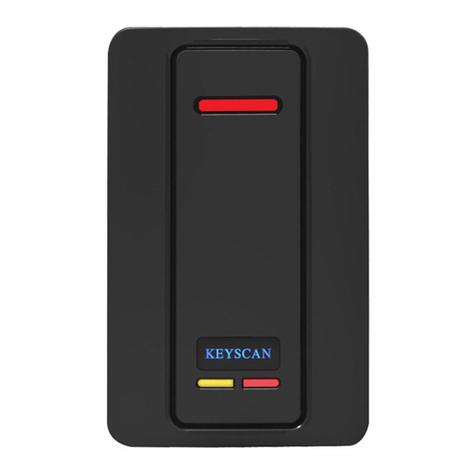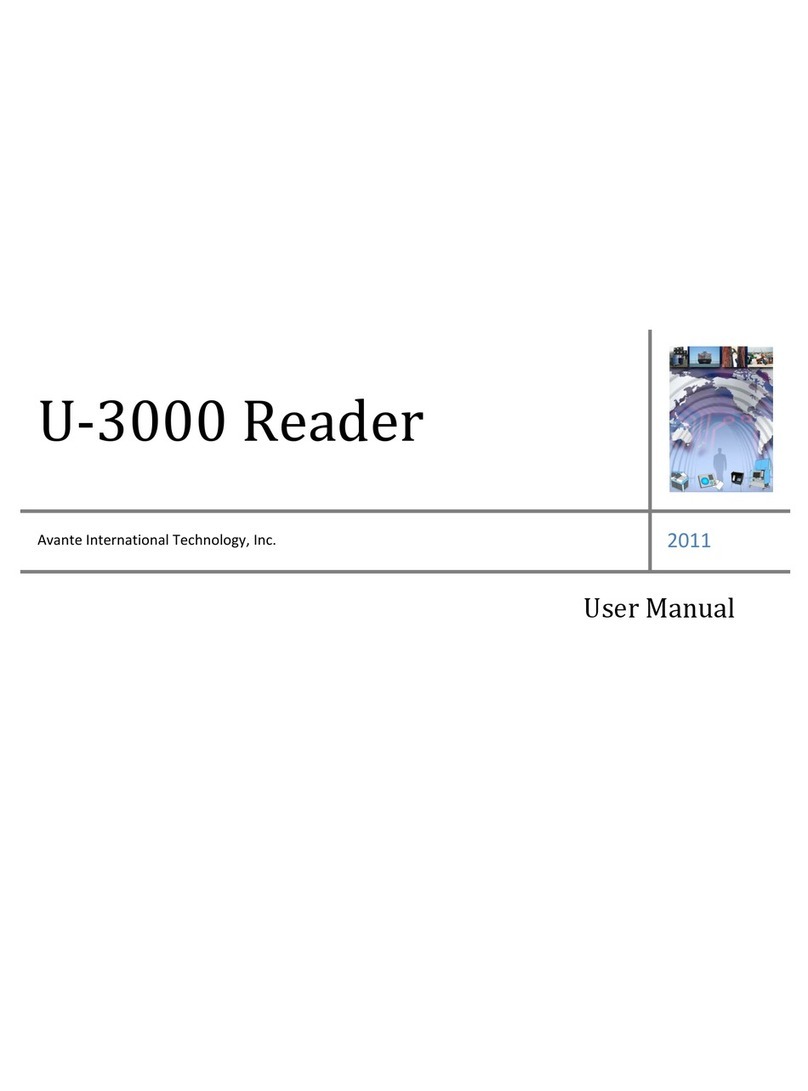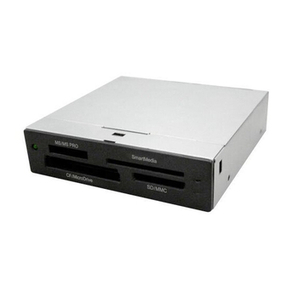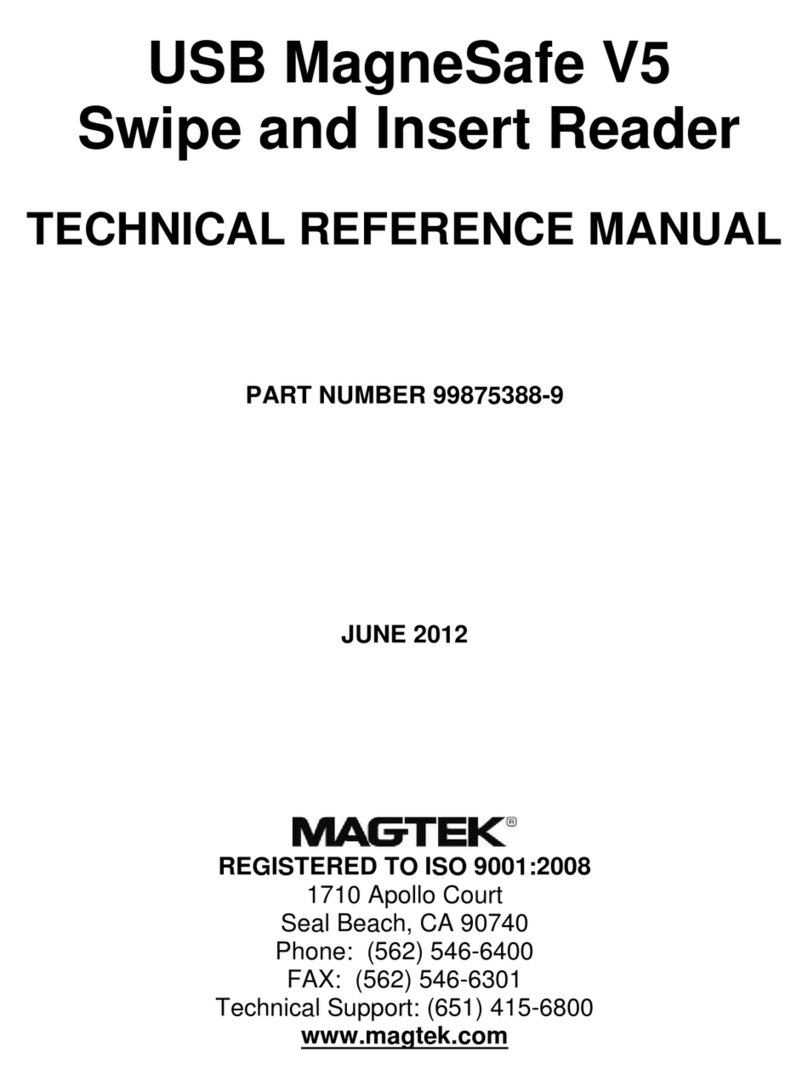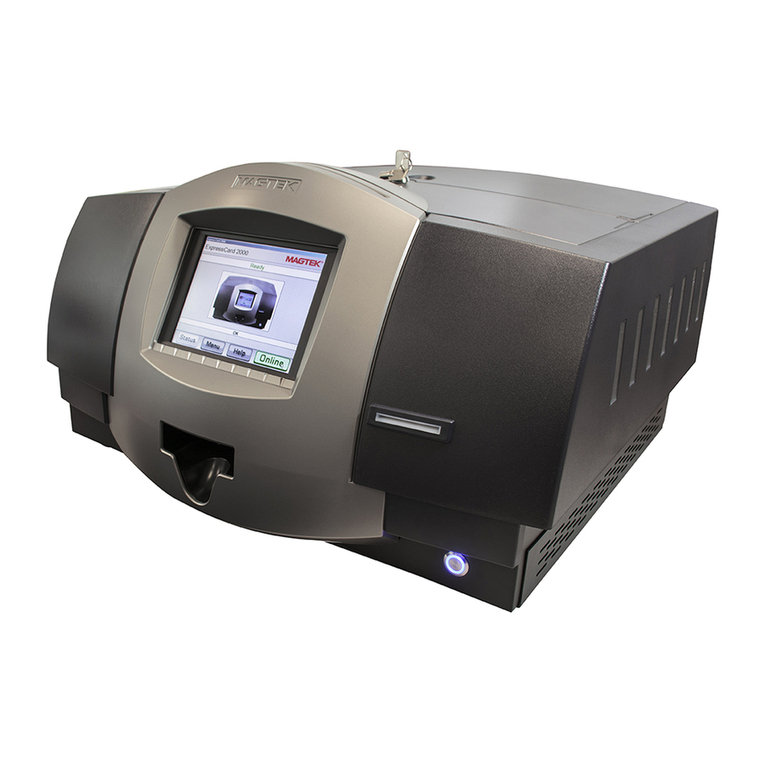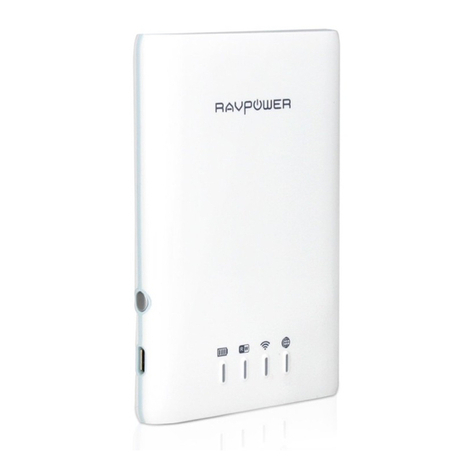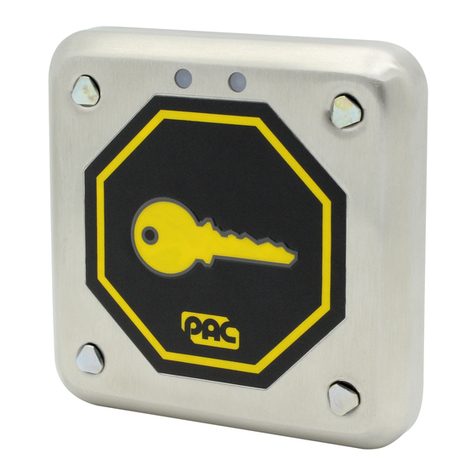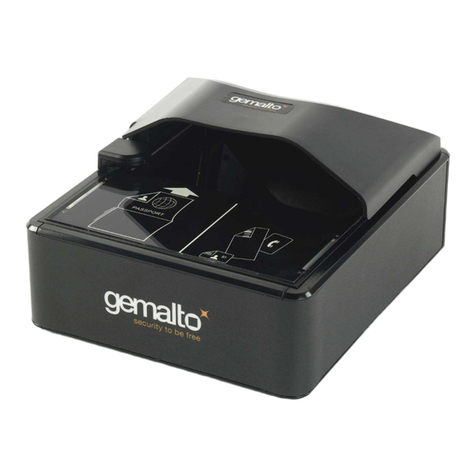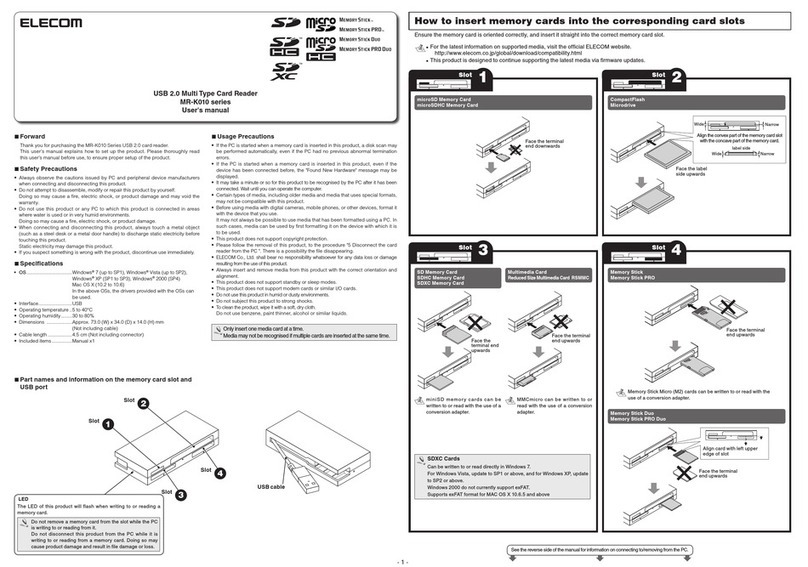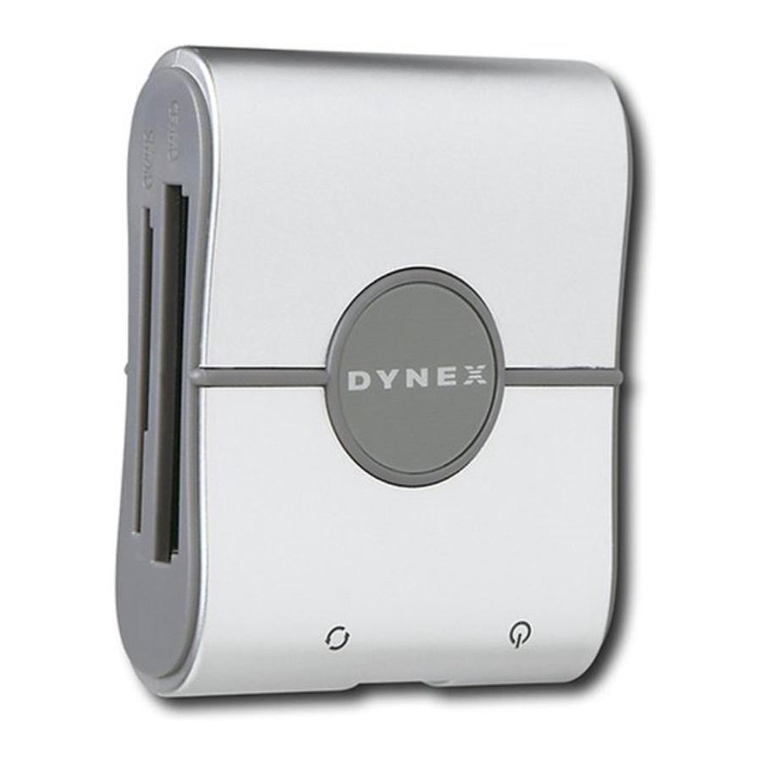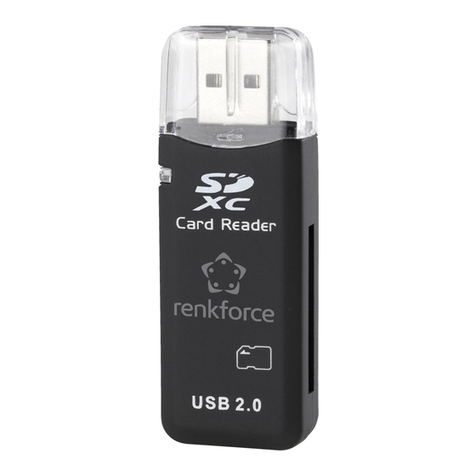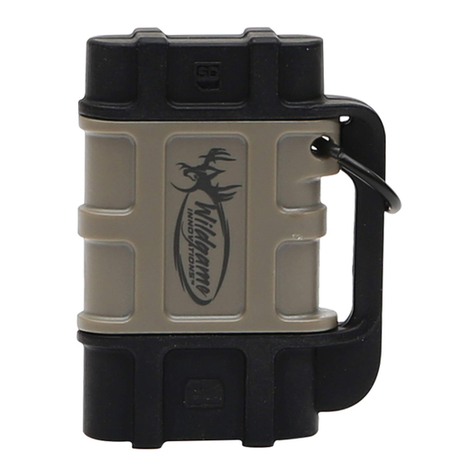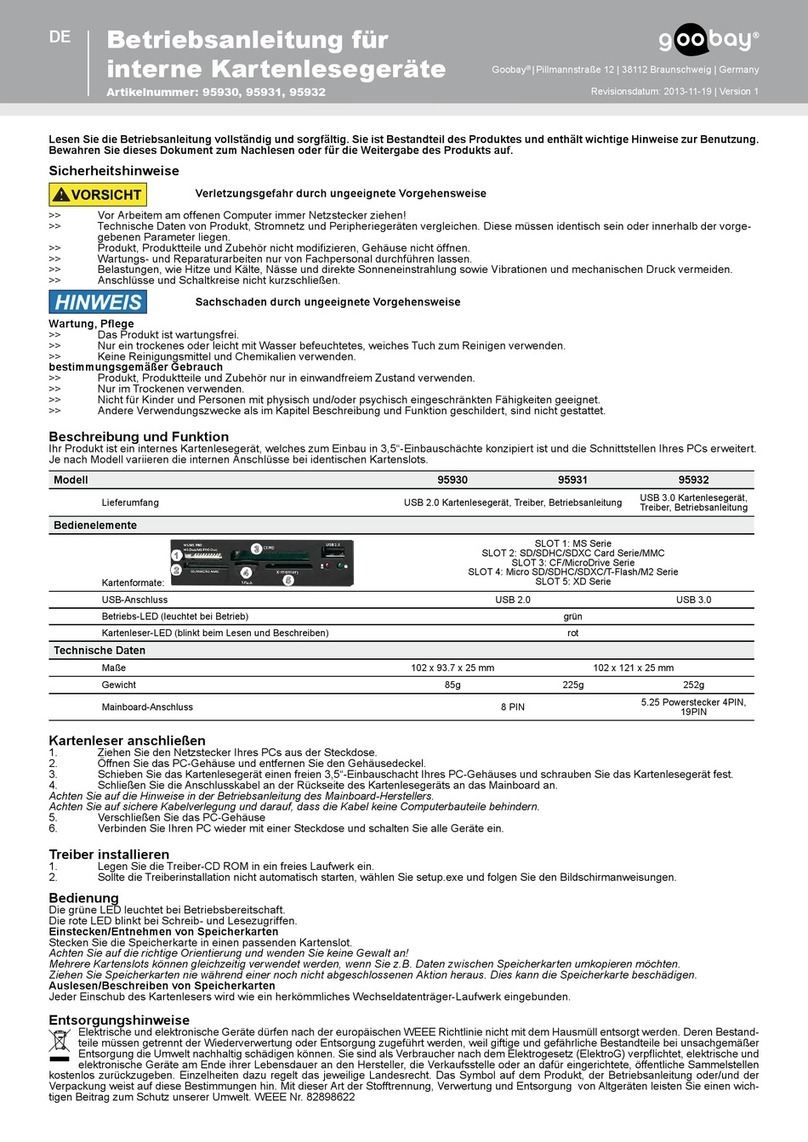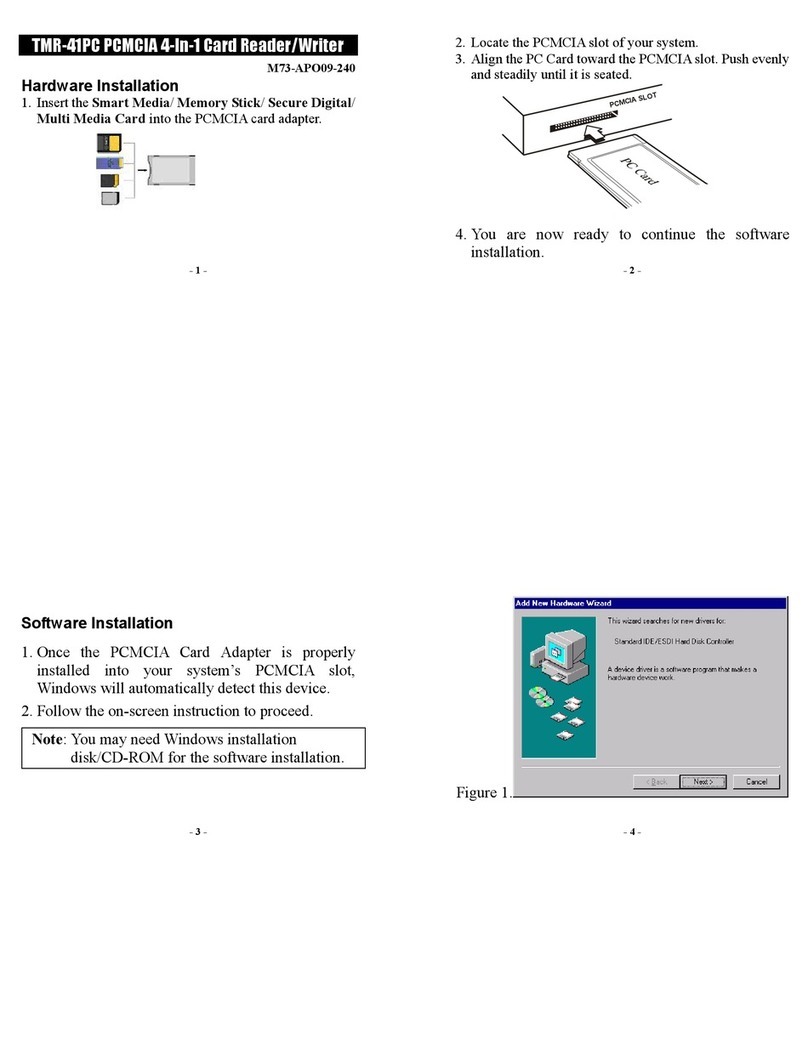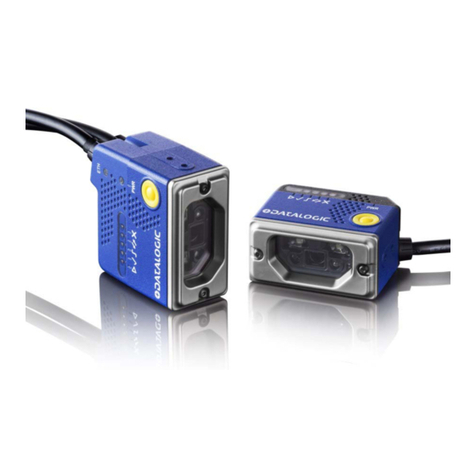IDENTEC SOLUTIONS i-MARK 2 Assembly Instructions

i-MARK 2, i-MARK 3
System Description,
Installation and Hardware Manual

i-MARK 2 / i-MARK 3
USER MANUAL
VISIBILITY DELIVERED. PAGE 2 OF 55
Proprietary Notice
This document contains confidential information proprietary to IDENTEC SOLUTIONS and may not be
used or disclosed to other parties in whole or in part without prior written authorization from IDENTEC
SOLUTIONS.
Disclaimer and Limitation of Liability
IDENTEC SOLUTIONS AG and its affiliates, subsidiaries, officers, directors, employees and agents
provide the information contained in this Manual on an “as-is” basis and do not make any express or
implied warranties or representations with respect to such information including, without limitation,
warranties as to non-infringement, reliability, fitness for a particular purpose, usefulness,
completeness, accuracy or up-to-dateness. IDENTEC SOLUTIONS shall not in any circumstances be
liable to any person for any special, incidental, indirect or consequential damages, including without
limitation, damages resulting from use of or reliance on information presented herein, or loss of
profits or revenues or costs of replacement goods, even if informed in advance of the possibility of
such damages.
Trademarks
“IDENTEC SOLUTIONS”, “Intelligent Long Range”, “ILR” and the stylized “i” are registered
trademarks and “i-Q”, “i-D”, “i-B”, “i-CARD”, “i-PORT”, “i-LINKS”, “Solutions. It’s in our name.”,
“Smarten up your assets” are trademarks of IDENTEC SOLUTIONS, Inc. and/or IDENTEC SOLUTIONS
AG.
Copyright Notice
Copyright © 2011 IDENTEC SOLUTIONS. All rights reserved.
No part of this document may be reproduced or transmitted in any form by any means, photographic,
electronic, mechanical or otherwise, or used in any information storage and retrieval system, without
the prior written permission of IDENTEC SOLUTIONS.
Reg. No. IM.0732.EN
Issue 7 / March 2011
– 16. March 2011 –
IDENTEC SOLUTIONS AG,
Millenium Park 2, 6890 Lustenau, Austria
Phone: +43 5577 87387- 0, Fax: +43 5577 87387-15
www.identecsolutions.com
Subject to alteration without prior notice.
© Copyright IDENTEC SOLUTIONS 2011
Printed in Austria
Radio Frequency Compliance Statement
IDENTEC SOLUTIONS is the responsible party for the compliance of the following devices:

i-MARK 2 / i-MARK 3
USER MANUAL
VISIBILITY DELIVERED. PAGE 3 OF 55
Radio Frequency Compliance Statement
IDENTEC SOLUTIONS is the responsible party for the compliance of the following devices:
MODEL: i-MARK 2 i-MARK 3
FCC ID: O2E-ILR-IM2 O2E-ILR-IM3N
CANADA: 3538B-IM3
EUROPE: CE CE
The user(s) of these products are cautioned to only use accessories and peripherals approved, in
advance, by IDENTEC SOLUTIONS. The use of accessories and peripherals, other than those approved
by IDENTEC SOLUTIONS, or unauthorized changes to approved products, may void the compliance of
these products and may result in the loss of the user(s) authority to operate the equipment.
Operation is subject to the following conditions: (1) these devices may not cause harmful interference,
and (2) these devices must accept any interference, including interference that may cause undesired
operation of the device.
FCC Compliance
This equipment has been tested and found to comply with the limits for a Class A digital device,
pursuant to Part 15 of the FCC Rules. These limits are designed to provide reasonable protection
against harmful interference when the equipment is operated in a commercial environment. This
equipment generates, uses, and can radiate radio frequency energy and, if not installed and used in
accordance with the instruction manual, may cause harmful interference to radio communication.
Operation of this equipment in a residential area is likely to cause harmful interference in which case
the user will be required to correct the interference at his/her own expense.
Warning: Changes or modifications to this unit not expressly approved by the party responsible for
compliance could void the user’s authority to operate the equipment.
Industry Canada Compliance
This Class A digital apparatus meets all requirements of the Canadian Interference-Causing Equipment
Regulations.
Cet appareil numérique de la classe A respecte toutes les exigences du Règlement sur le matériel
brouilleur du Canada.

i-MARK 2 / i-MARK 3
USER MANUAL
VISIBILITY DELIVERED. PAGE 4 OF 55
Important Note
To comply with FCC radio frequency exposure compliance requirements, this device must be installed
by an IDENTEC SOLUTIONS certified technician. When installing antennas, a 20 centimeter passing
distance must be maintained from any body part of the user, or nearby persons and the antenna.
The installer of this radio equipment must ensure that the antenna is located or pointed such that it
does not emit RF field in excess of Health Canada limits for the general population; consult Safety
Code 6, obtainable from Health Canada.
European Notification according R&TTE Directive
This equipment complies to Art. 6.4 of R&TTE Directive (1999/5/EC). It is tested for compliance with the
following standards:
EN 300 220-1 V1.3.1 (2000-09), EN 300 220-3 V1.3.1 (2000-09), ETSI EN 301 489 V1.4.1 (2002-08), ETSI
EN 301 489 V1.4.1 (2002-08)

i-MARK 2 / i-MARK 3
USER MANUAL
VISIBILITY DELIVERED. PAGE 5 OF 55
This product contains components that are sensitive to electrostatic discharges. Please observe the
special instructions for their protection. Incorrect handling can damage the unit and cause the
invalidation of the warranty.
Minimum safety precautions against electrostatic discharge:
Establish earth contact before you touch the unit. For example, touch the earthing screw on the
unit. Even better: Use an antistatic ribbon and earth yourself permanently for the time you
handle the unit.
Avoid unnecessary contact with the unit connectors and assemblies inside the unit.
Only open the unit if the operational settings (as described in the manual) expressly require this.
Use antistatic tools for the setting of the unit. (Warning: Do not touch life-threatening voltages
with these tools).
Do not store unit and components without protective packaging.
Only remove unit and components from the packaging immediately prior to installation.
These notes are not sufficient to guarantee complete protection from electrostatic
discharges! We recommend the use of suitable protective equipment.

i-MARK 2 / i-MARK 3
USER MANUAL
VISIBILITY DELIVERED. PAGE 6 OF 55
CONTENTS
1SAFETY INSTRUCTIONS ...............................................................................................9
2INTRODUCTION..........................................................................................................11
2.1PREPARATIONS .......................................................................................................... 11
2.2SCOPE OF THIS DOCUMENT........................................................................................... 11
2.3RESPONSIBILITY......................................................................................................... 11
2.4UPDATES ................................................................................................................. 12
2.5SCOPE OF DELIVERY—VISUAL INSPECTION........................................................................ 12
2.6ASSOCIATED DOCUMENTS............................................................................................. 12
2.7BLUETOOTH MODULE .................................................................................................. 12
2.8INTERNAL MAINS SUPPLY ............................................................................................. 12
2.9COMPATIBILITY.......................................................................................................... 12
3TECHNICAL OVERVIEW..............................................................................................13
3.1THE MARKER-TECHNOLOGY........................................................................................... 13
3.2THE POSITION MARKERS.............................................................................................. 13
3.3THE TAGS ................................................................................................................ 14
3.3.1The i-B2L Tag (Beacon Technology)......................................................................... 14
3.3.2Surveillance Tag..................................................................................................... 14
3.3.3Marker Field Test Tag ............................................................................................. 15
3.3.4The i-Q8L Tag (Response Technology, Reader Talks First).......................................... 15
3.3.5The i-Q350L Tag..................................................................................................... 16
4THE MARKER FUNCTIONS IN DETAIL ........................................................................17
4.1THE MARKER TAG AND THE INDUCTIVE LOOP...................................................................... 17
1.1.1.Marker tag appears in Position Marker’s loop field...................................................... 17
1.1.2.Marker tag remains in Position Marker’s loop field...................................................... 17
1.1.3.Marker tag leaves Position Marker’s loop field............................................................ 17
4.2ABOUT TIMER VALUES ................................................................................................. 17
4.3ABOUT THE RSSI....................................................................................................... 17
4.4THE INDIVIDUAL LOOP ID ............................................................................................ 18
5SYSTEM COMPONENTS...............................................................................................19
5.1COMPONENT OVERVIEW ............................................................................................... 19
5.2POSITION MARKERS.................................................................................................... 21
5.2.1i-MARK 2................................................................................................................ 21
5.2.2i-MARK 3................................................................................................................ 21
5.3DATA TAGS .............................................................................................................. 22
5.3.1i-B2L Tag............................................................................................................... 22
5.3.2i-Q8L Tag............................................................................................................... 22
5.3.3i-Q350 Tag............................................................................................................. 23
5.3.4Polarization of Tags................................................................................................. 24
5.4CENTRAL UNITS......................................................................................................... 25
5.4.1i-Port MB................................................................................................................ 25

i-MARK 2 / i-MARK 3
USER MANUAL
VISIBILITY DELIVERED. PAGE 7 OF 55
5.4.2i-Port MQ............................................................................................................... 25
5.4.3i-PORT 4................................................................................................................ 26
5.4.4i-PORT M 350......................................................................................................... 27
5.5ANTENNAS (EU ONLY)................................................................................................. 28
5.5.1Elliptical Polarized Antennas..................................................................................... 28
5.5.2Linear Polarized Antennas........................................................................................ 29
6MARKER LOOP INSTALLATION...................................................................................30
6.1GENERAL ................................................................................................................. 30
6.2LOOP GEOMETRY........................................................................................................ 30
6.3LOOP TURNS............................................................................................................. 31
6.4INSTALLATION........................................................................................................... 31
7INSTALLATION OF THE I-MARK.................................................................................33
7.1MECHANICAL INSTALLATION .......................................................................................... 33
7.1.1i-MARK 2................................................................................................................ 33
7.1.2i-MARK 3................................................................................................................ 35
7.2ELECTRICAL INSTALLATION ........................................................................................... 36
7.2.1Safety Instructions.................................................................................................. 36
7.2.2Useful Note............................................................................................................ 36
7.2.3Position of Ports ..................................................................................................... 36
7.2.4DC Power Supply.................................................................................................... 37
7.2.5Mains Power Supply (i-MARK 2 only) ........................................................................ 37
7.2.6The i-BUS Connectors ............................................................................................. 39
7.2.7Maximum Overall Cable Runs of i-BUS...................................................................... 40
7.2.8The External Marker Loop (i-MARK 3 only)................................................................ 40
8INITIAL OPERATION..................................................................................................42
8.1GENERAL ................................................................................................................. 42
8.2TOOLS REQUIRED ....................................................................................................... 42
8.3CONNECTING TO THE I-MARK 2/3 FOR CONFIGURATION....................................................... 42
8.4ILR CONFIGURATION TOOL—OVERVIEW .......................................................................... 43
8.5EXAMPLE CONFIGURATIONS........................................................................................... 45
8.6DETAILS ON SPECIFIC SETTINGS..................................................................................... 47
8.6.1Operation Mode—Continuous/host only .................................................................... 47
8.6.2Synchronization—Slave/master ................................................................................ 47
8.6.3Synchronization Mechanism..................................................................................... 48
8.6.4Slot Configuration Examples .................................................................................... 48
8.7CHECKING THE INSTALLATION........................................................................................ 49
8.8STATUS DISPLAY (LEDS) ............................................................................................. 49
8.9LOOP ERROR............................................................................................................. 50
8.10TAG CONFIGURATION .................................................................................................. 50
9MAINTENANCE ...........................................................................................................51
9.1GENERAL ................................................................................................................. 51
9.2TAG BATTERY LIFE ..................................................................................................... 51
9.3PRECAUTIONARY MAINTENANCE...................................................................................... 51

i-MARK 2 / i-MARK 3
USER MANUAL
VISIBILITY DELIVERED. PAGE 8 OF 55
9.4EXCHANGING A MARKER WITHIN THE DAISY CHAIN ............................................................... 51
9.5FIRMWARE UPDATE..................................................................................................... 52
9.6SPARE PARTS ............................................................................................................ 52
9.6.1Recommended spare parts stock.............................................................................. 52
9.6.2Preparing the spare parts........................................................................................ 52
9.6.3Examination and repair of exchanged parts............................................................... 52
9.7RETURNS ................................................................................................................. 52
10TECHNICAL SPECIFICATIONS....................................................................................54
10.1OPERATING DATA....................................................................................................... 54
10.2ELECTRICAL DATA ...................................................................................................... 54
10.3MECHANICAL DATA..................................................................................................... 54
10.4ENVIRONMENTAL CONDITIONS ....................................................................................... 54

i-MARK 2 / i-MARK 3
USER MANUAL
VISIBILITY DELIVERED. PAGE 9 OF 55
1SAFETY INSTRUCTIONS
The system described in this manual is for exclusive operation by trained employees. Only qualified
personnel that know the potential dangers involved should perform the installation, settings,
maintenance and repair of the units used.
Operational Safety
The correct and safe use of these systems assumes that operating and service personnel follow the
safety measures described in the manual alongside the generally acceptable safety procedures.
If there is a possibility that safe operation cannot be guaranteed the system must be switched off and
secured against accidental use. Then the service unit responsible must be informed.
Safety Documents
This ILR system was designed, tested and supplied in perfect condition according to document IEC348
Safety Requirements for Electronic Units of Class 1.
Condensation/Change of Temperature
Moving the systems from a cold to a warm environment could lead to dangerous situations due to
condensation. Therefore it must be ensured that the system can adjust itself to the warmer
temperature.
Do not open the housing
There is no need to open the housing in order to set any ILR unit. No unit has any internal setting
elements or displays. All settings are performed using software via the Service Interface.
Earthing
Before establishing any connections the housing of the system must be earthed.
Connections / Power Supply
The mains power supply must be equipped with an easy and safely accessible remote emergency cut-
off switch. The mains power supply must be equipped with an over-current protective device that
limits current to 16 A.
During maintenance, damage could occur if printed circuit boards or cables are connected or
disconnected whilst the power supply is still on. Therefore only work on the connection and the
components when they are not live.
The power supply circuit must comply with the requirements of the SELV circuits (see EN 60950).
The signal circuits must comply with the requirements of the SELV circuits (see EN 60950).
The RS422/i-BUS signal circuits must comply with the requirements of the TNV-1 circuits (see EN
60950).

i-MARK 2 / i-MARK 3
USER MANUAL
VISIBILITY DELIVERED. PAGE 10 OF 55
Use a ferrite rod for all signal cabling and place it close to the units. Use screened cables for all signal
cabling. This is the only way to achieve the prescribed EMC.
The device uses RS422 levels on its RX and TX Pins, although Ethernet jack/plugs mechanically fit, the
device is not Ethernet compatible!
Fuses
Only experts who are aware of the dangers involved may replace the fuses. It must be ensured that
only fuses of the required current rating and the correct type are used for replacement. The use of
repaired fuses and/or short-circuiting the fuse holders is prohibited.
Spare Parts
We recommend that only personnel, original products, spare and replacement parts authorized by
IDENTEC SOLUTIONS be used for installation, service and repair. Otherwise IDENTEC SOLUTIONS
does not accept any responsibility for materials used, work carried out or possible consequences.
Electrostatic Discharge
Semi-conductors of the type MOS or CMOS as well as two-pin types and precision resistance are
sensitive to ESD. All components, printed circuit boards and auxiliary systems should therefore always
be classed as sensitive to electrostatic discharge.
Before opening the cover the unit should be placed onto an ESD-protected surface. As with all work
on modern electronic modules the use of ESD clamps and ESD mats during work on the unit is
recommended.
Sufficiently protect all printed circuit boards that were removed from the unit from damage.
Observe all normal precautions for the use of tools.
Use ESD-protected packaging material.
Never use measuring units with low impedance for measuring or testing systems with semi-conductor
components. Never use high voltage testing units or dielectric test units to test systems with semi-
conductor components.
If it is necessary to check the isolating properties of the field wiring, the assemblies (electronic units
and sensors) should be disconnected.
Earth the test units.
IDENTEC SOLUTIONS does not accept returns of products where the regulations concerning the ESD
precautions and protective packaging materials were not followed.
ESD – Electrostatic Discharge
EMC – Electromagnetic Compatibility
SELV – Safety Extra Low Voltage – Protective measure against dangerous body currents, formerly: protective first voltage range

i-MARK 2 / i-MARK 3
USER MANUAL
VISIBILITY DELIVERED. PAGE 11 OF 55
2INTRODUCTION
Compact Unit i-MARK 2
Central unit i-MARK 3
2.1 Preparations
This installation manual must be read carefully prior to starting the installation. The described
installation works assume that installation materials like cable, antenna and data tag holder etc are
available.
2.2 Scope of This Document
This document is the hardware description of both the i-MARK 2 and i-MARK3. This document is
intended only for mechanical and electrical installation of this central units. A general system
description, especially of the position marker technology can be found in the extra system description;
please see below.
2.3 Responsibility
IDENTEC SOLUTIONS is not responsible for any errors contained in this document.

i-MARK 2 / i-MARK 3
USER MANUAL
VISIBILITY DELIVERED. PAGE 12 OF 55
2.4 Updates
Information contained in this document may change without prior notice. It remains the responsibility
of the end-user to request up-to-date documentation.
2.5 Scope of Delivery—Visual Inspection
Check delivery whether it is complete and for any damages. If the delivery is not complete or
damaged immediately inform the carrier. The dispatch and service organization of IDENTEC
SOLUTIONS should also be informed to facilitate the repair or exchange of the system.
2.6 Associated Documents
If using i-B2L tags refer to he i-B2Programmer Software Manuel for configuration of the tags.
If using i-Q350L tags refer to the “ILR Tag Configuration Software Manual” for configuration of
the tags.
The i-Q8L tag is a response tag and doesn’t need to be configured.
2.7 Bluetooth Module
The Bluetooth module is optional, when installed it enables Bluetooth devices to communicate with a
position marker.
Note that the Bluetooth interface only allows communicating with the device itself and does not
forward the messages on the RS422 bus.
2.8 Internal Mains Supply
By standard the i-MARK 2 and i-MARK 3 operate with a power supply of 10 – 30 VDC.
As an option the compact unit i-MARK 2 is available with an internal power supply to operate at a
mains voltage of 100 – 240 VAC (Europe only).
2.9 Compatibility
Both, the i-MARK 2 and i-MARK 3 are compatible with the following tags:
i-B2L
i-Q8L
i-Q350L
i-Q350TL
i-Q350TEL

i-MARK 2 / i-MARK 3
USER MANUAL
VISIBILITY DELIVERED. PAGE 13 OF 55
3TECHNICAL OVERVIEW
3.1 The Marker-Technology
The Marker technology is a combination of 2 types of wireless data transmission:
1. The fixed Position Marker provides an inductive loop. The LF signal in the loop contains a position
ID. A tag that recognizes the Position Marker’s loop field reads and stores this ID.
2. Long-Range-RFID is then used to communicate with and identify the tag and read the Position
Marker ID that equals the position of the tag.
3.2 The Position Markers
There are several Position Markers of different design. Their basic function is always the same:
The Position Marker operates an inductive loop and transmits its preconfigured ID every 20 ms.
The difference is that some Position Markers have a built-in antenna (e.g. compact unit i-MARK 2)
whose antenna loop has a fixed shape and can be adjusted in its 3D size. On the other hand there are
Position Markers that operate an external customized loop antenna (e.g. the i-MARK 3) to fit to the
desired application.
Typically these Markers are configured once during initial installation and keep on working without
need for maintenance.
Marker Loop
ILR
i-PORT Antenna
Transponder
868/915 MHz
up to 100 m
Inductive Loop
i-MARK
125 kHz
up to 3 m
Host-PC
+

i-MARK 2 / i-MARK 3
USER MANUAL
VISIBILITY DELIVERED. PAGE 14 OF 55
3.3 The Tags
There are 2 types of tags. But the marker function ob both work in the same matter. The difference is
only how the long-range RFID communication works.
3.3.1 The i-B2L Tag (Beacon Technology)
The i-B2L tags steadily transmits a portion of data (17 Bytes) at a configurable rate, typically a few
seconds. In other words the tags RF transmission flashes every several seconds like the light of a
Beacon. This data contains:
Tag information (8 Bytes)
9 Bytes of User Data (pls. see table below)
Byte # Description
1 previous Position Marker ID LSB
2 previous Position Marker ID MSB
3 previous Position Marker Timer LSB
4 previous Position Marker Timer MSB
5 new Position Marker ID LSB
6 new Position Marker ID MSB
7 new Position Marker Timer LSB
8 new Position Marker Timer MSB
9 RSSI of new Position Marker
When a Beacon tag enters a Position Marker’s inductive loop field it rapidly sends out an adjustable
number of RF transmissions every 100 ms. This is called a „burst“. To avoid collisions with other i-B
tags, the 100 ms repeat rate of the burst is slightly randomized. This repeat rate (slot width) is also
adjustable
3.3.2 Surveillance Tag
The i-B2L S/EU-ED-SU is designed to keep the function of i-MARKs and i-PORTs under continuous
surveillance. They are intended to be mounted inside the range of the inductive field of an i-MARK’s
antenna.
Order code. 371 466

i-MARK 2 / i-MARK 3
USER MANUAL
VISIBILITY DELIVERED. PAGE 15 OF 55
3.3.3 Marker Field Test Tag
The i-B2L SL/EU is a test tag. It is intended the test the range of the marker field. This is needed in
order to set the current of the loop. The tag is equipped with an LED that blinks when the tag is in a
marker field.
Order code: 380 870
3.3.4 The i-Q8L Tag (Response Technology, Reader Talks First)
This tags never send out anything on their own, until they are asked for. Either by a scan command to
check for tags in the long-range RFID field or by directly addressing them by their unique tag ID.
So to interrogate and collect Marker information of let’s say tags somewhere in 4 tracks of the port of
a plant it is a good idea to use the “scan with data” command and give the ILR central unit the job to
get the tag IDs and the bytes that carry the Position Marker loop information from the memory of
several i-Q8L tags.
These are the mapped memory addresses of the Position Marker information in an i-Q data tag:
Address Type Description
0x0090 uint: 16 bits Previous Position Marker ID, LSB
0x0091 Previous Position Marker ID, MSB
0x0092 uint: 16 bits Time since this previous position had been left in steps of 1 sec, LSB
0x0093 Time since this previous position had been left in steps of 1 sec, MSB
0x0094 uchar: 8 bits Previous Position Marker 125 kHz RSSI value
0x0095 uint: 16 bits New Position Marker ID, LSB
0x0096 New Position Marker ID, MSB
0x0097 uint: 16 bits Time since this new position has been left in steps of 1 sec, LSB
0x0098 Time since this new position has been left in steps of 1 sec, MSB
0x0099 uchar: 8 bits New Position Marker 125 kHz RSSI value
Important Note
Be sure to read all 10 Bytes (length) at once starting address 0x0090 (offset) from the tag. Otherwise
you will not receive the correct data.

i-MARK 2 / i-MARK 3
USER MANUAL
VISIBILITY DELIVERED. PAGE 16 OF 55
3.3.5 The i-Q350L Tag
This new generation of tags can be configured to operate in beacon mode (similar to i-B2 tags) or in
response mode (similar to i-Q tags). The marker information is sent out by the tag (depending on the
tag configuration) in a burst or in pings (broadcast messages).
The marker information in a broadcast message contains the following data:
Byte # Description
1 previous Position Marker ID LSB
2 previous Position Marker ID MSB
3 previous Position Marker Timer LSB
4 previous Position Marker Timer MSB
5 RSSI of old Position Marker
6 new Position Marker ID LSB
7 new Position Marker ID MSB
8 new Position Marker Timer LSB
9 new Position Marker Timer MSB
10 RSSI of new Position Marker
The content of broadcast messages and the burst behavior is configurable. All the details are
described in the corresponding tag manual of the specific tag type and in the “ILR 350 Tag
Configuration Plug-In Manual”.

i-MARK 2 / i-MARK 3
USER MANUAL
VISIBILITY DELIVERED. PAGE 17 OF 55
4THE MARKER FUNCTIONS IN DETAIL
4.1 The Marker tag and the inductive loop
1.1.1. Marker tag appears in Position Marker’s loop field
Whenever a tag recognizes a new Position Marker’s inductive loop it does this:
Move values of new ID and timer to previous ID and timer
Stop and reset new timer to “0”
Re-Start timer for previous timer value
Additionally an i-B tag or an i-Q350 tag in beacon mode will send a configurable burst of RF
communication.
1.1.2. Marker tag remains in Position Marker’s loop field
When a tag remains in a Position Marker’s loop it does this:
New timer remains stopped
Previous timer counts up every second
1.1.3. Marker tag leaves Position Marker’s loop field
When the tag finally leaves the current inductive loop, then it does this:
Start new timer, counts up every second
Old timer remains counting up
The tag decides to have left the loop field after he hasn’t recognized the same Position ID for more
than 1 sec. This inhibit time avoids lost of previous Position information for short time of interrupted
recognition of the loop field.
4.2 About Timer Values
The timers are 16 bits wide and count up every100 milliseconds. After a timer has reached it’s
maximum value of 0xFFFF or 6553,5 seconds, it stops. So the maximum time is: 1 h, 49 m, 13.5 s.
4.3 About the RSSI
This value of the signal strength of the inductive loop that is recognized by the tag, is the maximum
field strength the tag has discovered while having been in a specific loop field.

i-MARK 2 / i-MARK 3
USER MANUAL
VISIBILITY DELIVERED. PAGE 18 OF 55
4.4 The Individual Loop ID
The Loop ID (Marker ID) must be in the range from 1 … 65520. So “0” and numbers above 65520 are
not allowed.

i-MARK 2 / i-MARK 3
USER MANUAL
VISIBILITY DELIVERED. PAGE 19 OF 55
5SYSTEM COMPONENTS
5.1 Component Overview
Application with i-Q8L tags
Application with i-B2L tags using the ILR SDK
ILR SDK
i-MARK 2 / i-MARK 3
i-PORT MB i-PORT MQ
i-B2L i-Q8L
ILR Gateway
Software
ILR Reader Module
ILR Transponder
Marker
i-PORT 4 B
i-B2 i-Q32T i-Q8
ILR SDK
i-MARK 2 / i-MARK 3
i-PORT MQ
i-B2L i-Q8L
ILR Gateway
Software
ILR Reader Module
ILR Transponder
Marker
i-PORT 4 B
i-B2 i-Q32T i-Q8
i-PORT MB
i-PORT 4 B

i-MARK 2 / i-MARK 3
USER MANUAL
VISIBILITY DELIVERED. PAGE 20 OF 55
Application with i-B2L tags using the i-SHARE edgeware
Application with i-Q350L tags
i-SHARE
i-MARK 2 / i-MARK 3
i-PORT MQ
i-B2L i-Q8L
ILR Gateway
Software
ILR Reader Module
ILR Transponder
Marker
i-PORT 4 B
i-B2 i-Q32T i-Q8
i-PORT MB
i-PORT 4 B
ILR SDK
i-MARK 2 / i-MARK 3
i-Q350L
ILR Gateway
Software
ILR Reader Module
ILR Transponder
Marker
i-PORT M 350
i-SHARE
i-Q350
i-PORT M 350 RTLS
i-Q350TL
This manual suits for next models
1
Table of contents
